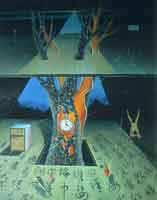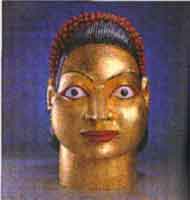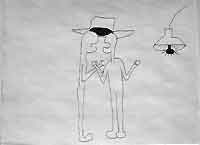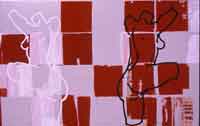

From Artspiral Magazine Issue #1
"Negotiating
Modernisms: Contemporary Asian Art and The West," 1996
by Thomas McEvilley
 |
 |
| Eastern Wang, "Untitled", 1982 | Ravinder Reddy, "Head IV," 1995, polyesther, fiberglass, 47 1/4 x291/8 x 401/2 inches |
The exhibition Traditions/ Tensions: Contemporary Art from Asia, which was originated by the Asia Society and opened at three venues in New York City in October 1996, contains contemporary art from India, Indonesia, the Philippines, Thailand, and South Korea. The work is "contemporary" not only because it is being made today but also because it is self-consciously historicity in a framework that gives some account of its relationship to the West as well as to its own tradition. I have written elsewhere (Frieze, January 1997) about the exhibition's structure and some of the artwork in it. Here I would like to mention briefly an important issue that has been in the air for some time but has not been openly discussed enough.
In 1991 in this publication, Robert Lee conducted an interview with several young artists from a Chinese group called Star Star, which had been formed in 1979, partly in connection with the Democracy Movement. Around 1985, as Sui Kang Zhao, a member of Star Star, said, "The art movement really started... Things were happening so fast, trying to keep up meant breaking through yourself... " In that year Li Xiaosan wrote an influential article called "The Death of Tradition" in which he argued that every artist should "experiment freely, abandon all strict technical norms and rigid aesthetic standards" in pursuit of a breakthrough into artistic renewal in China. These artists who had come of age after the Cultural Revolution were self-consciously involved with the project of connecting to Euro Modernism. As Wenda Gu, another member of Star Star, put it: "It was revolutionary, it was incredible. Almost 100 years of western modern art repeated itself in only five years in China. Expressionism, Surrealism, Dada, Performance Art, Action Art, everything, everything..."
Modernism established itself in many countries, and that some of these, not having access to the center of the discourse, remained "marginalized modernism [s]."
There seemed to be an underlying assumption that to get to Modernism, or Late Modernism, or post-Modernism, one had to go through the West. This assumption is, needless to say, both powerful and controversial. Some of the Asian curatorial advisers who wrote essays in the Traditions/ Tensions catalogue engaged in fascinating ruminations on this issue as they sketched out a spectrum of positions relating to Star Star's. Indonesian curator and author Jim Supangkat, for example, introduces the useful term "multimodernism." He points out that Modernism established itself, in one style or another, in many countries, and that some of these, not having access to the center of the discourse, remained "marginalized modernism[s]." Surely he is right about that. Supangkat says that Indonesian Modernism has existed for some time but unacknowledged in Europe and America, the situation is similar for many nations. Several years ago a show called Czech Modernism toured the United States, demonstrating convincingly that Czech culture had participated in the 20th century adventure of Late Modernism, though unacknowledged in the record. I have seen similar exhibitions in Skopje, Macedonia, and Ljubliana, Slovenia, where also highly developed Modernisms existed yet were historically marginalized by various forces-- in these cases above all the Iron Curtain. These marginalized Modernisms were carried out more or less in isolation. Today cultures seeking to enter Modernism or perhaps post -Modernism find easier access to the international discourse.
The Star Star experience indicates one mode of entering Modernism after being long cut off from it: the accelerated mimesis of Euro- Modernism seen as a short-cut into the present. Like the raft of Buddhism after one has crossed the river, it can be abandoned after its lessons have been learned. Quite another view has been adumbrated by Indian critic Geeta Kapur, who writes that "in order for an African or Asian avant-garde to come into its own, it must ... dismantle the burdensome aspect of Western art, including its endemic vanguardism." A true avant-garde, she argues, following Peter Burger, "can only be situated in a moment of real historical or political disjunctive." Thus the avant-garde which began in the United States and Europe not long after World War II is a neo-avant-garde, not the real thing but it seems more plausible if it is applied to the ongoing avant-gardism" of the recent American tradition (what Harold Rosenberg called "the tradition of the new") is, on this view, either a market device or a kind of spastic reflex or morbid repetition compulsion of an Ideological State Apparatus, the foot of a dying rabbit vainly kicking and kicking the air. In pursuing the idea of local avant-gardes (not unlike multi-modernisms) Kapur comes directly to the point: "There is no reason whatsoever." she writes, "for the rest of the world to subscribe to the vocational stringencies of the American neo-avant-garde." Indeed, it does seem clear that multimodernisms might arise with their own modes of history, without reference to Euro-Modernism except for the fact that the very idea of history seems to have developed in the West, from Thucydides to Hegel. It is implied that the American model is a burden because it pretends, in tiresome complicity with the long imperial project, to appear as, and to feel itself as, an absolute or universal. "An Indian artist," Kapur writes "does not aspire to be part of the monumental trans-avant-garde." Kapur seems clearly right when she observes that "contemporary Euro-American cultural discourse cannot function without a recognition of the major shake ups in its hegemonic assumptions." But is this a prescription (for the future) or a description (of the recent past)? It seems to refer to what the post-Modern discourse in Europe and the United States has been trying, with deliberation, to accomplish.
Jae-ryung Roe, writing in a fascinating essay for the Korean position, note that the South Korean government, in 1995, announced a national program of globalization which would amount to "the rebirth of modern Korea." "An era of globalization, national prosperity, and ultimate unification lay before the Korean people." There was a background to the moment. After the artistically oppressive post- war period of American occupation, the Infirnel Group "identified themselves with the postwar generation of European artists and with the movement Art Informal." Chronologically there is a certain parallel with the emergence of other internationalizing groups in the early post-war period, such as the Bombay Progressives, Subsequently Korean Star Star describes as a hundred years experienced in five: "Op Art, assemblage geometric abstraction, conceptual and performance art." So Korean artists, like some Chinese, subjected themselves to an initiation into the Western avant-garde canon that Kapur--speaking, of course, from within one of the world's massively dominant traditions, a global center second to none for ages--declares irrelevant to Indian artists. But that's not the whole story. In Korea as elsewhere the post-colonial conscience reacted. In the 1980's the People's Art movement espoused the belief that "Korean modernism was a result of misguided attempts to mimic the West and a by-product of neocolonialism and cultural imperialism. " Jae-ryung Roe seems to feel that a kind of synthesis has occurred through a "clear distancing from the past and from the history of modernism, a mastery over the anxieties about the assimilation of Western modernism, and a redemption from the previous obsession with national identity and tradition." So the confrontation seems to have been fruitful: Modernism redeemed them from their tradition, while their tradition distanced them from Modernism and its anxieties. Still, that is not the whole story either; the attitudes and desires shift back and forth. In 1995 the first Kwangjiu Biennial was huge public success while "many in the Korean art community regarded the biennial as a failure." "They pointed out that it was not a truly international event, that it lacked overseas promotion and international press coverage, and that it did not succeed in promoting the segehwa [globalization] of Korean art."
As Carl Jung once remarked, you never solve your problems, you just outgrow them. In the long run the resolution may look like another detail in the chronology of Chinese contemporary art. A Chinese Dadaist of the 1970's and 80's, Huang Yong Ping, put a book titled History of Chinese Painting and a book titled History of Western Painting into a washing machine together. The pages disintegrating in the churning hot soapy water suggested a gradual melt-down of cultural boundaries and a cleansing away of traditional identity in both East and West.
Huang felt that his idea was equally inspired by western Dadaism and Chinese Zen.
Thomas McEvilley is an Art History professor at Rice University, a contributing editor for Artforum and a senior advisor for Trans. He also contributed to the catalogue accompanying Contemporary Art in Asia: Tradition/Tensions, and spoke at the symposium Fast Forward: The Contemporary Art Scene in Asia.
| |||

|

|
||
|
Uhn Lin, "Phobe," 1992 pen on paper, 11x8 1/2 inches |
Wei Wei Ai, "Either, Neither," 1984 128"x72" from the 1991 exhibition, "From 'Star Star' to Avant Garde" |
||
[ close window ]